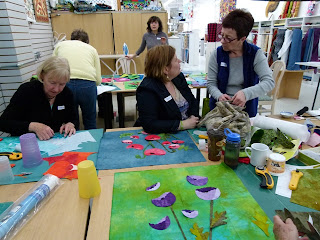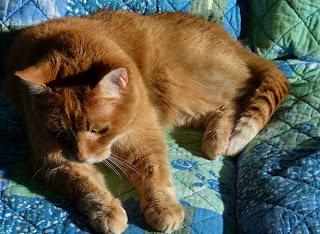After posting photos of my multi-coloured fabrics in my April 10 blog post, Laura asked if I might share how I dye them. She was referring to fabrics like the ones in the photo above. However, I use this very same method for most of the fabrics I dye, although the colours will vary.
For multi-hued fabric like those above, I start with three primary colours, a yellow, a red and a blue. For the brightest palette, I choose yellow, fuschia and turquoise. For a bit earthier palette, I choose golden yellow, scarlett and sky blue. This doesn't mean, however, that I can't use the bright blue (turquoise) in the earthy palette, and vice versa. Sometimes I will even combine two sets of primaries in one piece of fabric (yellow, golden yellow, fuschia, scarlett, turquoise and sky blue) or I might do two yellows, two reds, and only one blue. Or sometimes I might use a navy blue instead of turquoise or sky blue. Experiment! It is the serendipitous end results that got me addicted to dyeing!
Bright palette of yellow, turquoise and fuschia
Earthy palette of golden yellow, scarlett, and sky blue
To prepare my fabric for dyeing, I rip it into the sizes I want, and throw it in my washer to rinse and spin. I always start dyeing with wet fabric (unless I am using a soda soak method). When dyeing for my business I like to work with one-meter pieces. I dye them in plastic food containers purchased at Dollarama. If you prefer to dye fat quarters, I like to do those on a plastic or styrofoam plate (in classes I teach, we pop the plate into a Zip Lock bag to make it easier and cleaner to transport home).
I mix up my dyes at full strength (1 Tb. dye powder per cup of water) for a good intense colour. You can adjust this downward if you prefer medium or light values. Remember, with turquoise you always need to use twice as much dye powder! I do use urea in the dye solution to increase the dye's solubility in water.
You can see I've scrunched my wet fabric up and placed it in the containers. This is what causes that nice mottled look you see in hand-dyes. I usually begin with the yellow dye. You are going to need a lot more yellow dye to do these multi-hued fabrics than you will red or blue. Why? Because yellow is a lighter value than red or blue and could easily be obliterated if you add too much red or blue. Once you do add red to the yellow, you are going to see some orange developing where the yellow and red mix. You will also start to see green developing when you add blue to the yellow because yellow and blue combined result in green. Finally, once you add the red and the blue, some of that will mix to form purple. It always takes way more yellow than red to produce orange and way more yellow than blue to produce green. In the sample below I've decided to add both yellow and golden yellow to make the fabric even more complex.
Here is the one meter version in process
In the step below I've added the red.
And finally, in the last step of adding colour, I've added the blue, and you can see some green starting to show.
In all cases, you only want to add as much dye as the fabric will soak up. If you add more than that, there will be puddling of all three primary colours in the bottom of the container, and you know what happens then, right? You'll get some mud (brown). I don't mind a little of this as it often tones the intense brightness down in these fabrics, but too much is not a good thing. If you want brighter, clearer colours, you could always try the soda soak method (starting with dry fabric, soaking it in soda ash solution, wringing, and then applying dye). I have done this but it caused problems for my shoulders wringing the large quantities of fabric I need to dye for my business.
Before I start any dyeing episode, I mix up my soda ash solution in a jug, so that once the dyes are applied, I can add it. I add one cup of the solution to the meter of fabric
and I will add 1/4 cup of the solution to the fat quarter. The recipe is always one cup of soda ash solution per meter of fabric, so if you are doing 1/4 meter of fabric you will adjust accordingly.
Once I'm finished, I will let the fabric batch for about 24 hours. Reds strike really fast, but blues, particularly turquoise, can take up to 24 hours for full development of colour. Then it is time for the rinsing and washing.
Keep in mind that this method can be used with other colours as well. If you want a really complex blue, try mixing up several blue dyes and adding them to the same piece of fabric. You can also mix across colours, using several greens and a blue or blues on the same piece of fabric. I taught myself to dye so I am not a dyeing purist. Yes, there is a lot you can do by only working with primaries and mixing all your own colours, but I find it so much more interesting to also purchase already mixed colours and play with those. I think that is actually the secret to the loveliness of my hand-dyes, if I do say so myself.
In my next post I will share photos of the fabrics once washed out. I will also be sharing how I made my latest quilt, Red Stool II, pictured below. It is my contribution to SAQA's One Foot Square auction this year.






































